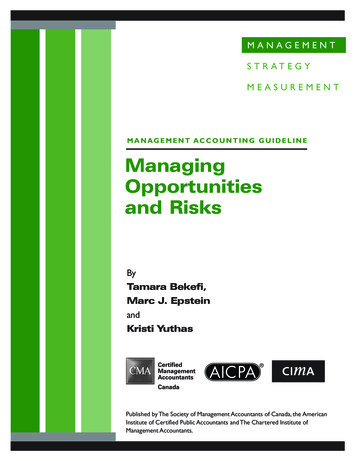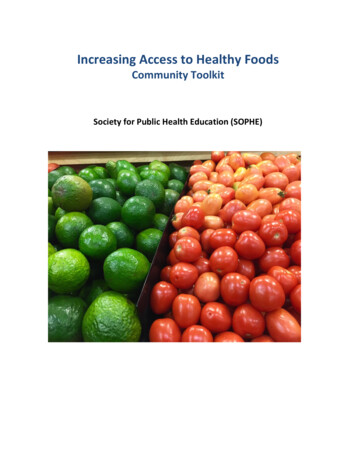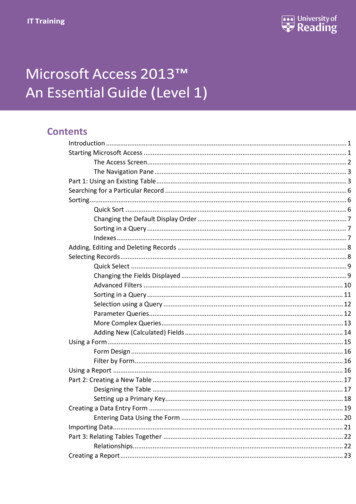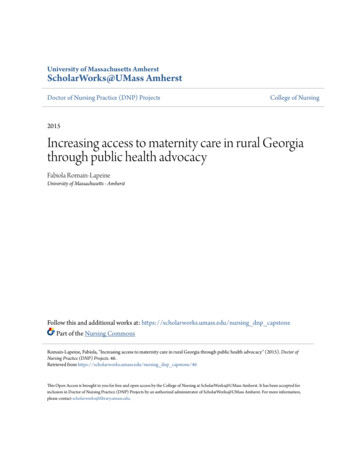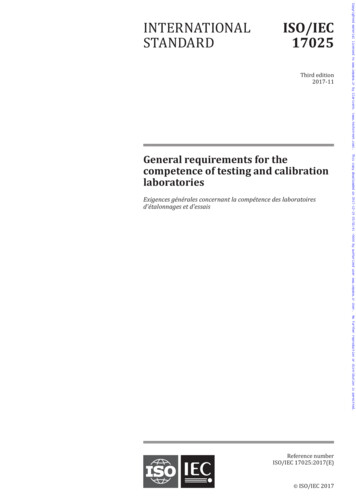
Transcription
JUNE 2010
Access to Healthy Foods Coalitionwww.accesstohealthyfoods.orgWashington State Department of HealthPO Box 47890Tumwater WA 98504360-236-4030www.doh.wa.govCenter for Public Health NutritionUniversity of Washington306 Raitt Box 353410Seattle WA 98195206-616-1569www.cphn.org
ACKNOWLEDGEMENTSThis publication was supported by Washington State Department of Health (DOH) through CooperativeAgreement Number 5U58DP001491-02 from the Centers for Disease Control (CDC) and Prevention. Its contentsare solely the responsibility of the authors and do not necessarily represent the official views of DOH or CDC.ADVISORSAccess to Healthy Foods CoalitionChair:Kyle Unland, Spokane Regional Health DistrictVice Chair:David Bobanick, Rotary First HarvestTreasurer:Karen Bonaudi, WA State Potato CommissionSecretary:Mary Podrabsky, UW Center Public Health NutritionMember:Eric Hurlburt, WA State Department of AgricultureWashington State Department of HealthAmy Ellings, MPHNutrition ConsultantFruit & Vegetable Nutrition CoordinatorNutrition, Physical Activity and Obesity ProgramNutrition and Obesity Policy, Research and Evaluation Network (NOPREN)UNIVERSITY OF WASHINGTON TEAMDonna Johnson, RD, PhDAssociate Professor, Nutritional Sciences, AssociateDirectorCenter for Public Health NutritionCorinne McCuskey, MPAResearch CoordinatorCenter for Public Health NutritionMary Podrabsky, MPH, RDDirector of School & Community InitiativesCenter for Public Health NutritionKaren Holt LuetjenResearch CoordinatorCenter for Public Health NutritionChristy Alexander, MUPTricia DeMarco, MSCE, MUPSPECIAL THANKSTo leaders from all components and sectors of the Washington State Food System who took the time to talk to usabout access to healthy foods.
TABLE OF CONTENTSChapter 1PURPOSE, DEFINITIONS AND FRAMEWORKS1Purpose, Definitions, Systems, FrameworksChapter 2SYSTEMS THAT IMPACT ACCESS TO HEALTHY FOODSIN WASHINGTON STATE8Health and Food InsecurityAgricultureThe EnvironmentINTERVIEW METHODS AND RESULTS: BARRIERSTO ACCESS TO HEALTHY FOODS AND EXAMPLESOF CURRENT WASHINGTON STATE INITIATIVES TOADDRESS THEM24Chapter 4PROMISING STRATEGIES: A REVIEW OF EXPERTRECOMMENDATIONS35Chapter 5GOING FORWARD66Chapter 3Opportunities for Increasing Access to Healthy Foods: What weLearned from Interview RespondentsNeed for Information, Evidence and ResearchStrategic Opportunities for Moving Forward: Combining InterviewResponses with Promising StrategiesAppendix 1SURVEY QUESTIONS73Appendix 2STRATEGIES TABLE74Appendix 3ACTIONS FOR THE ACCESS TO HEALTHY FOODSCOALITION TO SUPPORT THESE PROMISINGOPPORTUNITIES100
CHAPTER 1PURPOSE, DEFINITIONS AND FRAMEWORKSThe concepts that are explored in this report are complex. The project advisors and work team establisheddefinitions and frameworks to assure common understandings and guide the methods of data collection andanalysis. The first part of the chapter provides: Purpose of the project. Definitions of healthy food, access to healthy food and food systems.The major themes for the rest of the chapter are: Healthy food access is a component of many interrelated systems, and problems with food access requirecollaborative solutions. Many sectors have a role to play in improving access. Goals for increasing access to healthy foods in the population are set within goals for a healthy economy,healthy environment, and healthy people. Better access will be achieved by simultaneous actions that include individuals and families, communities,institutions, regional food systems and state and national policy changes.Opportunities to Increase Access to Healthy Foods in Washington, page 1
Access to healthy foodis determined by complexand interrelated food andeconomic systems.Individuals must have:Physical Access: Proximityto food retailers and reliabletransportationFinancial Access: Sufficientresources and affordablefoodNutritional Access:Availability of sufficient foodto meet nutritional needsCultural Access: Availabilityof culturally-relevant andfamiliar foodsWhat are Healthy Foods?Healthy foods provide anindividual with a balanceddiet that meets nationaldietary guidelines andprovides plenty ofvegetables, fruits, wholegrains, low fat dairyproducts and healthy fatslike olive and canola oil andprotein, such as lean meatsand legumes.A Healthy Food Systemthat enhances access tohealthy foods for thepopulation will help to meetthese overarching goals:PURPOSE OF THE REPORTAccess to healthy food is essential to the health and productivity ofWashington’s residents, but most do not consume diets that meetrecommendations for health. As a result, rates of diabetes, heart disease andobesity continue to rise, and these health problems impact the economicproductivity of the state. At least 15% of Washington’s residents are foodinsecure ‐‐ that is, they do not have consistent access to healthy foods. Accessto food is essential for a productive work force; children need food tosupport health and success at school.We can improve access through cooperative and simultaneous actions thatimpact families, institutions, communities and the state as a whole.Agriculture is a strong sector in Washington’s economy, and many of thefoods produced in the state are health promoting. Supporting the economicviability of farming and increasing access to healthy foods strengthensWashington’s economy.The purpose of this report is to describe opportunities to improve access tohealthy foods in Washington State for the Access to Healthy Foods Coalitionso that Coalition members and other stakeholders in Washington State canprioritize initiatives and integrate resources.OVERARCHING GOALSBecause of the interrelated systems that support access to healthy foods it ishelpful to consider changes in physical or financial access to healthy foods inthe context of these larger systems. The conceptual model displayed inFigure 1 was developed by the project team and advisors. Overall,improving access to healthy foods will help achieve all three goals: peoplewill get healthier, the economy will improve and the environment will beprotected and sustained. Health, economic and environmental systems inturn are related to many other factors beyond the scope of this report. Thisreport is based on the following precepts: Any opportunities to be considered by the stakeholders should worktoward at least one of these interrelated goals The best opportunities will address two or three of the goals. No opportunity will negatively impact any of the goals.SIMULTANEOUS ACTIONS ON SEVERAL LEVELSImproving access will best be achieved by simultaneous actions that includeindividuals and families, communities, large and small institutions, regionalfood systems, and state and national policy changes. This report is organizedby these categories.Figure 1. Healthy Food SystemOpportunities to Increase Access to Healthy Foods in Washington, page 2
Complex Adaptive System:many pieces interactingwith each other in nonlinearways that influence theoverall behavior of thesystem.“Wicked” problems:complex, cross cutting,difficult to define, relentless,no clearly described set oftrue solutions.A systems approach: Form cooperative andcross disciplinary teams Consider all actors inthe system Be aware of unintendedconsequences Consider multilevelapproaches Distribute decision,action and authority Create feedback loopsand assesseffectivenessIndividuals & FamiliesThe foods available to families are influenced by local and regional foodsystems and the policies that drive those systems. Within the home, thefamily’s resources, knowledge and attitudes influence the kinds of foodavailable to children. Food marketing plays a substantial role in foodpreference.InstitutionsWhen worksites, schools, child care, sporting events, and faith communitiesprovide more healthy foods and fewer unhealthy foods, children and adultsare more likely to have healthy diets.CommunitiesCommunities influence food choice in several ways. Physical access to healthyfoods is determined by the kinds of foods that are available in neighborhoods,especially for families that do not have reliable transportation. In addition, thesocial norms and expectations of communities are potent influencers of foodchoices.Regional Food SystemsAccess to healthy foods is increased when local food production, processing,distribution and retail work together to build strong markets for healthy foods.Regional food systems enhance the economic viability of all the actors in thesystem.State and Federal PoliciesExisting policies and practices profoundly influence access to healthy foodsacross Washington State. Many of these have the unintended consequence ofdecreasing consumption of healthy foods. One of the goals of this report is tostimulate a discussion about these policies and practices with the hope thatbarriers to healthy eating can be reduced and enhancers of healthy foodchoices can be increased.Figure 2. Levels of Influence on Accessto Healthy FoodsOpportunities to Increase Access to Healthy Foods in Washington, page 3
National Health GoalsRelated to Access toHealthy Foods from HealthyPeople 2010 Increase food securityamong U.S. householdsand in so doing reducehunger. Increase the proportion ofpersons aged 2 years andolder who consume at leasttwo daily servings of fruit. Increase the proportion ofpersons aged 2 years andolder who consume at leastthree daily servings ofvegetables, with at leastone-third being dark greenor orange vegetables. Increase the proportion ofpersons aged 2 years andolder who consume at leastsix daily servings of grainproducts, with at least threebeing whole grains. Increase the proportion ofpersons aged 2 years andolder who meet dietaryrecommendations forcalcium. Increase the proportion ofchildren and adolescentsaged 6 to 19 years whoseintake of meals and snacksat school contributes togood overall dietary quality.(developmental)ACCESS TO HEALTHY FOODS AS A SYSTEMFood Access is Part of Large Systems & Requires a CollaborativeSolutionThe determinants of access to healthy foods are complex, and the solutionswill involve many actors. The situation requires systems thinking. Systemsapproaches are especially helpful ways to address complex problems byhelping many actors see the larger picture and not just their role in it. Systemsthinking takes into account large numbers of interacting parts, and has theadvantage of raising the level of thinking about a problem and fosteringeffective results in the context of the “big picture.” Traditional systemsthinking methods include the building of maps and models to determine thepoints at which change can have the greatest impact. Strategies that areadopted with the bigger picture in mind can produce greater and moresustainable benefits.A lack of access to healthy foods in all populations is a “wicked” problem.Wicked problems are unstructured, crosscutting, and relentless (1) and requirecollaborative capacity. Networks such as the Access to Healthy FoodsCoalition have evolved as a response to such problems because of their abilityto bring different organizations to the table to consider the issue.Collaboration is “a process through which parties who see different aspects ofa problem can explore constructively their differences and search for solutionsthat go beyond their own limited vision of what is possible.” Collaboration isa process that enables independent individuals and organizations to combinetheir human and material resources so they can accomplish objectives (2).”FRAMEWORKS TO IMPROVE ACCESS TO HEALTHY FOODSAccess to healthy foods is a complex process with many interrelated actors.This report uses two overarching organizational frameworks to address thissituation. The goals for increasing access to healthy foods in the populationare set within goals for a healthy economy, healthy environment and healthypeople (Figure 1). The barriers to healthy foods and opportunities forincreasing healthy foods are organized by an adapted version of the social‐ecological model (Figure 2). For this report, the levels are individual/family,institutional, community, regional systems and state and federal policies.This report uses the term Food System in the broadest sense to describe allcomponents from farm to consumption and beyond. Table 1 presents such afood system framework.Opportunities to Increase Access to Healthy Foods in Washington, page 4
Table 1. Food System Framework. Muller, Tagtow, Roberts, MacDougall. J Hunger Environ Nutr.2009. 4: sConsumptionResource andWasteManagementFarmingGardeningWild ationWholesalingWarehousingRetailFood ingDisposalRecyclingCompostingCOLLABORATION TO IMPROVE ACCESS TO HEALTHY FOODS IN WASHINGTONBoth governmental and non‐governmental organizations have a role in addressing the complex factors thatimpact access to healthy foods. These organizations will need to represent a diverse set of stakeholders including,“health professionals, public health advocates, policy makers, scientists, and small and large businesses (e.g.farmers, agricultural producers, food scientists, food manufacturers, and food retailers of all kinds) (3).A Role for GovernmentFive of the 10 Washington State Priorities of Government concern issues that are related to the goals of a healthyfood system and the impact of access to healthy foods for the population (4): Improve the economic vitality of business and individuals Improve student achievement in elementary, middle and high school Improve the statewide mobility of people, goods and services Improve the health of Washingtonians Improve the quality of Washington’s natural resourcesTable 2 provides examples of governmental goals and objectives around issues related to access to healthy foods.In addition to the departments of Health, Agriculture and Ecology, in Washington, the Departments ofCommerce, Transportation, Fish and Wildlife also have a role to play in the system, as does the ConservationCommission and the Office of the Superintendent of Public Instruction.Table 2. Examples of State and National Government Strategic Planning Related to Food Systems and Access to Healthy FoodsNationalMission, Vision or GoalWashington State DepartmentsObjectives &StrategiesMission, Vision or GoalObjectives, Strategies& ActivitiesHealthIncrease quality andyears of healthy life;Eliminate healthdisparities (5)Increase food securityamong U.S.households and, in sodoing, reduce hunger;specific goals for fruit,vegetables, wholegrains, calcium andschool meals (5)Improve healthoutcomes for thepeople of WashingtonState (6).Increase access tohealthy foods andopportunities forphysical activity (6).AgricultureProvide leadership onfood, agriculture,natural resources, andrelated issues basedon sound public policy,the best availablescience, and efficientmanagement (7)Enhance thecompetitiveness andsustainability of ruraland farm economies;improve the nation’snutrition and health;protect and enhancethe nation’s naturalresource base andenvironment (7)Facilitate themovement ofWashingtonagricultural products indomestic andinternational markets(8, 9).Promote the economicvitality of theagriculture industry,safeguard theenvironment; assistgrowers and agribusinesses to enternew markets (8, 9).Opportunities to Increase Access to Healthy Foods in Washington, page 5
EnvironmentProtect human healthand to safeguard thenatural environment -air, water and land -upon which lifedepends (10)Department ofEcology:Protect, sustain, orrestore the health ofcommunities andecosystems usingintegrated andcomprehensiveapproaches andpartnerships (10)Department ofEcology:Support sustainablecommunities andnatural resources (11)ConservationCommission:Wise stewardship,conservation, andprotection of soil,water and relatednatural resources (12)Dept of Ecology:Reduce and managesolid wastes; Improvewater quality; managethe sustainability ofwater resources (11)ConservationCommission:Support and guideconservation districts;information, guidanceand technical servicesfor private land ownersand managers indealing with land,water and air qualityconservation; educateabout the value andneed for naturalresource conservation(12)A Role for Non-Governmental OrganizationsMany non‐governmental organizations participated in the interviews that were conducted for this report. Pleasesee a list of those organizations in the Acknowledgements at the beginning of this report. These organizations: Advocate for systems that assure that all families have the resources they need to access healthy foods Advocate for systems that assure that food producers, processors, distributors and retailers operate within anenvironment that supports and encourages the provision of healthy foods at affordable prices for Washingtonresidents Provide safety net programs for families who do not have resources to access healthy foods Convene coalitions and groups of partners to come together to build strong systems that assure access tohealthy foods Disseminate information to build awareness about the importance of access to healthy foods and about what isneeded to increase access to healthy foods in the stateA Role for UniversitiesWashington’s public universities provide rich resources for improving access to healthy foods. Experts in publichealth, agriculture, nutrition, economics, planning, ecology, human behavior, and public administration areworking on the issue from several perspectives. Universities provide training, research, evaluation, technicalassistance, data, and assessment expertise.A Role for Providers of Coordination and Technical AssistanceAgencies and institutions like the county agriculture commissions, conservation districts and county offices of theWSU Extension Service provide education and coordination for the issues outlined in this report.A Role for Farmers, Growers and ProducersFood producers profoundly influence access to healthy foods, and they in turn must operate profitably within asystem that influences their decisions. These sectors must be part of decision making about opportunities toincrease healthy foods in the state.A Role for Businesses and Food Service SectorsIn Washington State there are many examples of innovative ways that businesses have contributed to access tohealthy foods. These include developing and marketing healthier food products, placing healthier foods at primelocations in retail establishments, and placing small grocery stores in neighborhoods that lack healthy foods.Opportunities to Increase Access to Healthy Foods in Washington, page 6
In Pierce County local restaurant owners partnered with the Tacoma Pierce County Health Department todevelop healthier menu items and provide nutrition information on menus (13). A local franchise owner in the South Puget Sound area has partnered with Thurston County Public Health &Social Services to pilot healthier options for kids meals in 10 locations. At the University of Washington, healthier food items are priced lower than some high fat/high sugar items.References1.Weber EP, Khademian AM. Wicked Problems, Knowledge Challenges, and Collaborative Capacity Buildersin Network Settings. Public Administration Review 2008;68:334‐349.2.Lasker RD, Weiss ES, Miller R. Partnership synergy: a practical framework for studying and strengtheningthe collaborative advantage. Milbank Q. 2001;79:179‐1IV.3.United States Department of Agriculture. Report of the Dietary Guidelines Advisory Committee on theDietary Guidelines for Americans. Available at: 4.Washington State Office of Fiscal Management. 2009‐2011. Priorities of Government Final Report. Availableat: �11.aspUS Department of Health and Human Services. Healthy People 2010. 2nd ed. Washington, D.C.: GovernmentPrinting Office, 2000.5.6.Washington State Department of Health. Strategic Plan 2009‐2013. Available at:http://www.doh.wa.gov/strategic/DOH 2009‐13 Strategic Plan.pdf7.United States Department of Agriculture. USDA Strategic Plan‐2005‐2010. Available df8.Washington State Department of Agriculture. Future of Farming: Washington Agriculture Strategic Plan 2020and Beyond. Available at: �PrinterFriendly.pdf9.Washington State Department of Agriculture. Strategic Plan 2009‐2011. Available lanFINAL2009‐11.pdf10. United States. Environmental Protection Agency. 2006‐2011 EPA strategic plan: charting our course.Washington, D.C.: Office of the Chief Financial Officer, Office of Planning, Analysis, and Accountability, U.S.Environmental Protection Agency, 2006.11. Washington State Department of Ecology. Available at: http://www.ecy.wa.gov/12. Washington State Conservation Commission. 2009‐2015. Strategic Plan. Available at:http://www.scc.wa.gov/index2.php?option com docman&task doc view&gid 549&Itemid 3813. Pulos E, Leng K. Evaluation of a voluntary menu‐labeling program in full‐service restaurants. Am J PublicHealth;100:1035‐9.Opportunities to Increase Access to Healthy Foods in Washington, page 7
CHAPTER 2SYSTEMS THAT IMPACT ACCESS TO HEALTHY FOODSIN WASHINGTON STATEAccess to healthy foods, agriculture, environmental health, human health, and the economy are all interrelated.This chapter provides background information on these topics and information about the relationships betweenthem.HEALTH AND FOOD INSECURITY Access to healthy foods is essential to the health and productivity of Washington’s residents. Access to healthy foods is an economic issue. Access to healthy foods is a geographic issue.AGRICULTURE Agriculture is an economic driver in the state. Washington has rich and diverse agricultural and food processing sectors that produce a variety of healthyfoods. There are several threats to the vitality of farming in the state. Strengthen agriculture: strengthen the economy.THE FOOD SYSTEM AND THE ENVIRONMENTOpportunities to Increase Access to Healthy Foods in Washington, page 8
HEALTH, FOOD SECURITY AND ACCESS TO HEALTHY FOODAccess to healthy foods isessential to health andproductivity.Healthy foods are neededfor: Healthy mothers andbabies during pregnancyand breastfeeding tosupport lifelong health Healthy growth inchildhoodWhat are Healthy Foods?Healthy foods are defined by the Dietary Guidelines for Americans, a science‐based system to provide the most up‐to‐date advice about diet and health inthe United States. The 2005 guidelines recommend eating a variety of fruitsand vegetables, low fat dairy and meats, whole grains, and healthy fats withincaloric needs while limiting intake of unhealthy fats, added sugars, sodiumand alcohol (1). People who follow the dietary guidelines are at lower risk foroverweight and obesity, and chronic conditions such as diabetes, hypertensionand cardiovascular disease (2‐5). However, the diets of most Washingtonresidents vary substantially from the recommendations. For example, as Figure3 shows, only about a quarter of Washington’s residents eat fruits andvegetables at least five times a day, and only 15.1% of Washington adultsreport consuming the two or more servings of fruit and three or more servingsof vegetables daily (6). Good schoolperformance in childhoodand adolescenceEat Fruits & Vegetables 5 Times A Day Among Adults inWashington, 1994-2007 Good work performancein adulthoodWashington30Age-Adjusted Percent Protection againstchronic diseases such ascancer, diabetes, andcardiovascular diseaseUS2026.5%21.7%10 Healthy 200520062007Source: Washington Behavioral Risk Factor SurveyNote: Only among adults who answered survey in English. Questions not asked on survey f or years without rate.Figure 3. Trends in Fruit and Vegetable ConsumptionIn 2010 in WashingtonState, the Emergency FoodAssistance Program isexperiencing a 19%increase in demandstatewide.The increase is projected tobe 38% by the end of 2010.This would be the greatestincrease in clients since theprogram began in 1981.The recent report of the Dietary Guidelines Advisory Committee (7) indicatesthat the 2010 guidelines will address the finding that the “majority (ofAmericans) are overweight or obese and yet undernourished in several keynutrients.” The report finds that, “on average, Americans of all ages consumetoo few vegetables, fruits, high‐fiber whole grains, low‐fat milk and milkproducts, and seafood and that they eat too much added sugars, solid fats,refined grains and sodium.” One highlight of the committee report was anemphasis on increasing seafood consumption. Washington agriculture can bepositioned to meet the demand that would ensue if Americans followed the2010 guidelines. To supply the recommended amounts of fruits and vegetablesto Americans, growers would have to double their fruit acreage and more thandouble vegetable acreage (8). The committee calls for a coordinated strategythat includes all sectors of society. The report specifically calls out the need forfarmers, agricultural producers, food scientists, food manufacturers and foodretailers of all kinds to be part of systems changes in these sectors.Opportunities to Increase Access to Healthy Foods in Washington, page 9
HEALTHY FOODS AND HEALTHY PEOPLEPoor diet, lack of physical activity, and tobacco use are the three top causes of early death and disease in the US(9). Most people choose their foods based on three things – taste, cost and convenience. When healthy foods areinconvenient and expensive people usually don’t choose them. Inexpensive foods that are high in fat, sugar andsalt are hard to resist. Lack of healthy foods and excessive exposure to foods that are high in fat, sugar and salt,contribute to obesity and many other health conditions.Figure 4. Model of Relationship between Access to Healthy Foods & HealthAge-Adjusted PercentFigure 8 shows rates of chronic diseases in Washington’s counties; it is clear that there are differences in diseaseprevalence across the state. Access to healthy foods helps to prevent these conditions, and once diseases likediabetes or heart disease have developed, healthy foods are essential for treating these diseases. Over time, ratesof chronic diseases such as diabetes have been steadily increasing in the state (Figure 5) especially among lowincome and minority groups and those with lower education levels (10). The prevalence of diabetes has increasedover 50% since the 1990s in Washington (10). Obesity is a risk factor for many chronic diseases, especiallydiabetes, and as Figure 6 shows, obesity rates have been increasing as well. In 2009 in Washington State, 62% ofadults were overweight or obese (11). Diseases related to poor diet are extending into the next generation. In 2008about 42% of Washington mothersDiabetes Among Adults in Washington, 1993-2008were either obese or overweightbefore pregnancy, and 47% gainedWashingtonUS20more than recommended amounts ofweight during pregnancy (12). In152008, 6% of women experienceddiabetes in pregnancy, with 5.3%diagnosed with gestational diabetes10(12). Diabetes in pregnancy is aserious condition that is associated6.7%5with increased risk of pregnancy4.0%complications and lifelong risk of0diabetes and obesity in babies who areborn to mothers with diabetes.Source: Washington Behavioral Risk Factor SurveyNote: Only among adults who answered survey in English.Figure 5. Trends in Diabetes Prevalence in Washington StateOpportunities to Increase Access to Healthy Foods in Washington, page 10
Obesity Among Adults in Washington, 1990-200850WashingtonUSAge-Adjusted Percent403025.4%201010%0Source: Washington Behavioral Risk Factor SurveyNote: Only among adults who answered survey in English.Figure 6. Trends in Obesity Prevalence in Washington StateACCESS TO HEALTHY FOOD IS AN ECONOMIC ISSUEOn the most basic level, the Washington State Department of Commerce includes food as a necessity for aproductive workforce (13). In addition, the chronic diseases that are associated with poor diet are major threats tothe economic vitality of Washington State. Health care spending costs attributed to obesity in Washington in 2008are estimated to be 1.8 billion; by 2013 obesity attributable costs will be almost 3 billion if trends continue (14).The true economic costs of chronic disease extend well beyond health care and include substantial loss ofproductivity by individuals and their caregivers.Many of Washington’s families do not consistently have access to healthy foods. Between 2006 and 2008 almost12% of Washington families had trouble providing enough food for all their members; these families were foodinsecure (15).About a third of Washington’s foodinsecure families had very low foodWashington %United States %6.0security where food intake wasactually reduced and normal eating5.0patterns were disrupted (see Figure 7).4.0Not all low‐income families are foodinsecure,and not all food insecure3.0families are low‐income. Rates of food2.0insecurity are higher for households1.0with incomes near or below thefederal poverty line and households0.0with children headed by singlewomen or single men (15). FamiliesSource: USDA Economic Research Servicerun into situations where they don’tFigure 7: Food Insecurity Trendshave enough money for food whenthey have family members with special needs, they have high medical costs and when housing and utility costsare lenceFood Insecurity with Hunger/Very Low Food SecurityCompared to food secure families, those that are food insecure have higher risk of many adverse outcomesincluding poor health, increased risk for the development of chronic diseases, poor psychological and cogniti
situation. The goals for increasing access to healthy foods in the population are set within goals for a healthy economy, healthy environment and healthy people (Figure 1). The barriers to healthy foods and opportunities for increasing healthy foods



